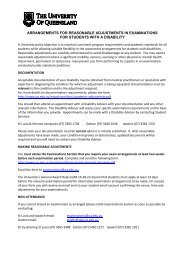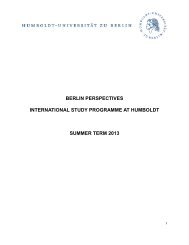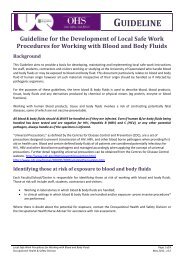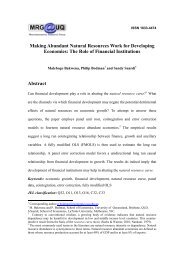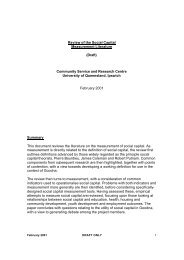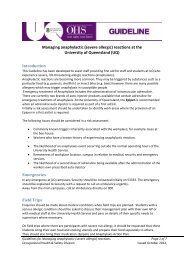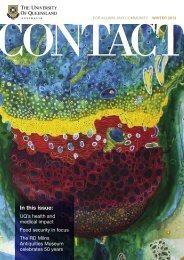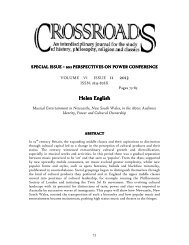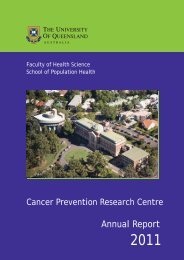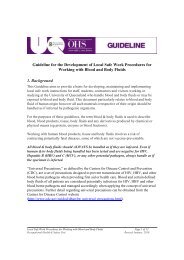Managing Traffic Incidents - University of Queensland
Managing Traffic Incidents - University of Queensland
Managing Traffic Incidents - University of Queensland
You also want an ePaper? Increase the reach of your titles
YUMPU automatically turns print PDFs into web optimized ePapers that Google loves.
Melbourne City Link Key Dates<br />
– Aug 1999 - Western Link opened to traffic<br />
(8 months after contracted completion date)<br />
– Jan 2000 - tolling commenced<br />
– April 2000 - Southern Link and Domain Tunnel open<br />
to traffic<br />
– Jan 2001 - repaired Burnley Tunnel opened to traffic<br />
The Concession<br />
CityLink has been developed by Transurban<br />
CityLink Limited, which have a market capitalisation<br />
in excess <strong>of</strong> AUD$1 billion, making it<br />
one <strong>of</strong> Australia's top 100 listed companies.<br />
Transurban was awarded the 'operating concession'<br />
to build, own, operate and transfer the<br />
City Link project on the basis <strong>of</strong> an agreement<br />
which allows the company to collect payment<br />
from users who wish to travel on the Link. The<br />
toll charges are controlled by a strict formula<br />
agreed with the local transport authorities.<br />
Transurban is committed to maintaining a<br />
high quality <strong>of</strong> service to its customers the road<br />
users, to collect tolls accurately and fairly 24<br />
hours a day, 365 days <strong>of</strong> the year. After 34<br />
years, the Melbourne City Link will be returned,<br />
in good operating condition and debtfree,<br />
to the state. The collection <strong>of</strong> tolls over<br />
this period is expected to pay for the initial investment.<br />
Tolling<br />
At the forefront <strong>of</strong> Transurban's highway revolution<br />
is its tolling system. CityLink is the<br />
world's largest application <strong>of</strong> electronic tolling<br />
technology in an urban road setting, making the<br />
project one <strong>of</strong> the first to commit fully to the<br />
concept <strong>of</strong> cashless tolling - which can be referred<br />
to as 3rd Generation Electronic Tolling.<br />
Experience — problems arise on major complex<br />
projects like City Link.<br />
Challenges<br />
Because all CityLink tolls are collected by<br />
this sophisticated electronic scanning system,<br />
there is no need for drivers to slow down or<br />
stop. Tolls are paid at freeway speeds resulting<br />
is fast, safe and stress-free travel. The benefits<br />
<strong>of</strong> multi-lane free-flow electronic tolling include<br />
no toll booths or boom gates, and no need<br />
for cash or tokens. The system has the capacity<br />
to collect fees and check a large number <strong>of</strong> vehicles<br />
simultaneously, which ensures that are<br />
never stop-and-go situations or queues. It is not<br />
a problem, however, to debit queuing vehicles.<br />
Each regular user fixes a small transponder,<br />
about the size <strong>of</strong> an audio cassette, behind the<br />
rear view mirror on the windscreen inside their<br />
vehicle. The transponder, known as an e-TAG®<br />
device, identifies the road user when the vehicle<br />
passes under gantries located every few kilometres<br />
along the tollway. There are nine Tolling<br />
Zones distributed along the roads forming the<br />
Melbourne City Link. The tolling strategy<br />
adopted for City Link is an open system with<br />
screenline gantries located along the route.<br />
For the whole City Link there are 17 tolling<br />
gantries ranging from two lane configurations<br />
to freeway standard cross sections involving<br />
four running lanes and emergency stopping<br />
lanes on each side. The tolling strategy incorporates<br />
a trip toll cap, which effectively places an<br />
upper limit on the toll payable for a single journey<br />
on the Link.<br />
Road safety and occupational health and<br />
safety were further issues in relation to the selection<br />
<strong>of</strong> a fully electronic tolling system. The<br />
stop start driving conditions associated with<br />
conventional plazas are eliminated. In addition,<br />
the exposure <strong>of</strong> employees to the relatively hazardous<br />
environment <strong>of</strong> a toll plaza is avoided.<br />
Outcome<br />
– Western Link opened to traffic, eight months after contracted<br />
completion date, tolling delayed for further four<br />
and half months<br />
– Delay in opening and tolling <strong>of</strong> Domain Tunnel and<br />
Monash Freeway sections <strong>of</strong> the Southern Link until<br />
three months after the contracted completion date<br />
– Unavailability <strong>of</strong> the Burnley tunnel due to the need to<br />
undertake major repairs to the floor slabs<br />
– Adverse impact on financial performance and the basis<br />
for a liquidated damages claim from construction joint<br />
venture contractor<br />
– Significant commercial issues and threat <strong>of</strong> major litigation<br />
– Late delivery <strong>of</strong> the Central Toll Computer System<br />
(CTCS), prevented tolling <strong>of</strong> the Western Link until four<br />
and a half months after opened to traffic<br />
– Significant inefficiencies in customer service and very<br />
high administration costs<br />
– Additional costs in manual transactions during critical<br />
period, plus adverse public perception due top customer<br />
service difficulties<br />
– Takeover <strong>of</strong> full responsibility for CityLink customer<br />
services from Translink Operations<br />
28 DECEMBER 2001




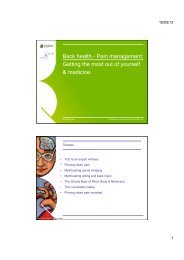
![Recycling [ PDF, 62KB ] - University of Queensland](https://img.yumpu.com/51805185/1/184x260/recycling-pdf-62kb-university-of-queensland.jpg?quality=85)
